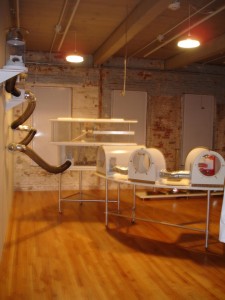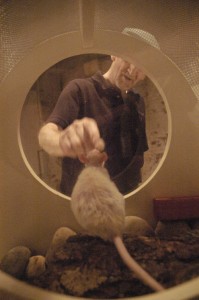Between 2004 and 2006, I created an installation, Embracing Animal, which involved exhibiting live transgenic lab rats.[1] This installation simulated a lab environment in order to study our understanding of the interactions between animals and humans – which in turn led back to the relationship between the rats and myself.
The installation involved a series of tall glass tubes for viewing films (such as Dr Jekyll/Mr Hyde and The Fly) that show the crossing of humans with other species, animal/people transformations (think werewolves and vampires), and the shifting space between human and beast. Next to the glass tubes was an extended animal cage, rambling over 20 feet, housing the three rats that were to call the installation home. Embracing Animal was thus an experimental playground in which to witness interspecies exchanges.
The premise of the project was to consider interspecies relations in a space that visually referenced a biology laboratory, and to conduct public experimental ’research‘ with the rats living in the installation. The rats in question were no ordinary rodents, however, rather they were transgenic rats (HLA B27 transgenics to be precise) purchased from a science research facility where they had been bred to carry particular autoimmune conditions similar to my own; microinjected with human DNA that preconditioned them to be autoimmune challenged.
Working with these rats (whose physiology is very close to humans) I could investigate my own chronic illness and could treat the rats with alternative medicines, enriched housing, play and food. Typically, the research done with these rats is conducted in ‘clean rooms’; sterile environments closed off from public scrutiny. In Embracing Animal, however, everything was reversed, with the animals in an open space, presented with challenges of new stimulae and with all aspects of their care on view. The habitat was built for surveillance, for observation and to see the unseen.
I identified with the rats – named Matilda, Tara and Star – and felt as though we were mirroring each other. Rats have historically been considered pests, associated with ‘carrying diseases’, but in a twist to this usual story, the animal that usually causes disease was here injected/polluted with human disease. With the help of Matilda, Tara and Star, I wanted to look at what is normally not seen: the research animal for my diseases. In the process, and through symbolic gesture, this project honored the millions of lab rodents who participate in the systems of medical/pharmaceutical/scientific research.
Throughout the exhibition of Embracing Animal at MASS MoCA, the entire staff was bought in to the project. Exhibiting live creatures requires a great deal of buy-in from the people overseeing the exhibit; in many ways this is an appropriate return to the origins of the term ‘curating to care’. The museum staff conducted tours and explained the transgenic make-up of the rats, their history and medical uses, as well as feeding, cleaning and nursing them. The staff learned to love the rats. In fact the night watchman, Mike Wilber, and his wife, Peg, played with the rats every night and, at the conclusion of the exhibition, adopted them. Their love was infectious; the rats thrived and enjoyed a good life.
The real importance of this kind of work is in the practice and exchange of care that is created through this very situation. The rats had many cheerleaders. Today, as care is undervalued, particularly when it comes to tending to bodies (be they human or non-human), the practice and ethics of care need to be explored further.
Kathy High
Kathy High is Head and Associate Professor of Video and New Media at the Department of the Arts, Rensselaer Polytechnic Institute, Troy, NY. She produces videos and installations posing queer and feminist inquiries into areas of medicine/bioscience, science fiction and animal/interspecies collaborations.
References
[1] Embracing Animal was exhibited at the Judi Rotenberg Gallery, Boston, MA, USA, in 2004, and as part of the “Becoming Animal” exhibition at MASS MoCA, North Adams, MA, USA, 2005–2006.
Read More
http://www.embracinganimal.com
 This work is licensed under a Creative Commons Attribution-NonCommercial-ShareAlike 2.5 Australia.
This work is licensed under a Creative Commons Attribution-NonCommercial-ShareAlike 2.5 Australia.








